Design of Polypropylene Electret Melt Blown Nonwovens with Superior Filtration Efficiency Stability through Thermally Stimulated Charging
Abstract
1. Introduction
2. Materials and Methods
2.1. Materials
2.2. Preparation of Melt Blown Nonwovens
2.3. Corona Charging
2.3.1. Annealing Treatment before Charging
2.3.2. Thermal Charging
2.3.3. Cyclic Charging
2.4. Characterization of the Melt Blown Nonwovens
3. Results
3.1. Melt Blown Nonwoven Web Properties
3.2. Filtration Performances of Samples That Are Annealed before Charging
3.3. Filtration Performances of the Thermally Charged Samples
3.4. Filtration Performances of the Samples with Cyclic Corona Charging
4. Conclusions
Author Contributions
Funding
Conflicts of Interest
References
- Liao, L.; Xiao, W.; Zhao, M.; Yu, X.Z.; Wang, H.T.; Wang, Q.Q.; Chu, S.; Cui, Y. Can N95 respirators be reused after disinfection? How many times? ACS Nano 2020, 14, 6348–6356. [Google Scholar] [CrossRef]
- Mahowald, N. Aerosol indirect effect on biogeochemical cycles and climate. Science 2011, 334, 794–796. [Google Scholar] [CrossRef]
- Liu, C.; Hsu, P.; Lee, H.; Ye, M.; Zheng, G.Y.; Liu, N.; Li, W.Y.; Cui, Y. Transparent air filter for high-efficiency PM2.5 capture. Nat. Commun. 2015, 6, 6205. [Google Scholar] [CrossRef]
- Zhang, S.C.; Liu, H.; Tang, N.; Zhou, S.; Yu, J.Y.; Ding, B. Spider-web-inspired PM0.3 filters based on self-sustained electrostatic nanostructured networks. Adv. Mater. 2020, 32, 2002361. [Google Scholar] [CrossRef]
- Thakur, R.; Das, D.; Das, A. Electret air filters. Sep. Purif. Rev. 2013, 42, 87–129. [Google Scholar] [CrossRef]
- Zhang, H.F.; Liu, J.X.; Zhang, X.; Huang, C.; Jin, X.Y. Design of electret polypropylene melt blown air filtration material containing nucleating agent for effective PM2.5 capture. RSC Adv. 2018, 8, 7932–7941. [Google Scholar] [CrossRef]
- Jackiewicz, A.; Werner, Ł. Separation of nanoparticles from air using melt-blown filtering media. Aerosol Air Qual. Res. 2015, 15, 2422–2435. [Google Scholar] [CrossRef]
- Thakur, R.; Das, D.; Das, A. Optimization study to improve filtration behaviour of electret filter media. J. Text. Inst. 2016, 107, 1456–1462. [Google Scholar] [CrossRef]
- Thakur, R.; Das, D.; Das, A. Optimization of charge storage in corona-charged fibrous electrets. J. Tex. Inst. 2013, 105, 676–684. [Google Scholar] [CrossRef]
- Das, D.; Thakur, R.; Pradhan, A.K. Optimization of corona discharge process using Box–Behnken design of experiments. J. Electrost. 2012, 70, 469–473. [Google Scholar] [CrossRef]
- Chen, G.J.; Xiao, H.M.; Wang, X. Study on parameter optimization of corona charging for melt-blown polypropylene electret nonwoven web used as air filter. In Proceedings of the IEEE 9th International Conference on the Properties and Applications of Dielectric Materials, Harbin, China, 18 September 2009; pp. 389–391. [Google Scholar]
- Gao, Y.; Du, B.X.; Yan, F.Y.; Hou, K.; Liu, Z.Y.; Chai, J.D. Effects of charging temperature and charging time on surface potential decay of PTFE film with back electrode ungrounded. In Proceedings of the 2011—14th International Symposium on Electrets, Montpellier, France, 28–31 August 2011; pp. 105–106. [Google Scholar]
- Kilic, A.; Shim, E.; Pourdeyhimi, B. Electrostatic capture efficiency enhancement of polypropylene electret filters with barium titanate. Aerosol Sci. Tech. 2015, 49, 666–673. [Google Scholar] [CrossRef]
- Lin, J.H.; Lou, C.W.; Yang, Z.Z. Novel process for manufacturing electret from polypropylene nonwoven fabrics. J. Text. Inst. 2004, 95, 95–105. [Google Scholar] [CrossRef]
- Kilic, A.; Shim, E.; Pourdeyhimi, B.; Yeom, B.Y. Aerosol filtration properties of nucleating agent containing electret filters. Polym. Eng. Sci. 2014, 54, 1533–1539. [Google Scholar] [CrossRef]
- Tabti, B.; Dascalescu, L.; Plopeanu, M.; Antoniu, A.; Mekideche, M. Factors that influence the corona charging of fibrous dielectric materials. J. Electrost. 2009, 67, 193–197. [Google Scholar] [CrossRef]
- Wang, S.; Zhao, X.L.; Yin, X.; Yu, J.Y.; Ding, B. Electret polyvinylidene fluoride nanofibers hybridized by polytetrafluoroethylene nanoparticles for high-efficiency air filtration. ACS Appl. Mater. Inter. 2016, 8, 23985–23994. [Google Scholar] [CrossRef]
- Liu, J.X.; Zhang, X.; Zhang, H.F.; Zheng, L.; Huang, C.; Wu, H.B.; Wang, R.W.; Jin, X.Y. Low resistance bicomponent spunbond materials for fresh air filtration with ultra-high dust holding capacity. RSC Adv. 2017, 7, 43879–43887. [Google Scholar] [CrossRef]
- Tang, M.M.; An, Z.L.; Xia, Z.F.; Zhang, X.Q. Electret properties and chemical modification of cellular polypropylene films. J. Electrost. 2007, 65, 203–208. [Google Scholar] [CrossRef]
- Thakur, R.; Das, D.; Das, A. Study of charge decay in corona-charged fibrous electrets. Fibers Polym. 2014, 15, 1436–1443. [Google Scholar] [CrossRef]
- Gao, H.C.; He, W.D.; Zhao, Y.B.; Opris, D.M.; Xu, G.B.; Wang, J. Electret mechanisms and kinetics of electrospun nanofiber membranes and lifetime in filtration applications in comparison with corona-charged membranes. J. Membr. Sci. 2020, 600, 117879. [Google Scholar] [CrossRef]
- Yamashita, T.; Ikezaki, K. A method for correlating charge traps of polypropylene to its morphology. J. Electrost. 2005, 63, 559–564. [Google Scholar] [CrossRef]
- Munir, J.; Ain, Q.; Lee, H.J. Reliability issue related to dielectric charging in capacitive micromachined ultrasonic transducers: A review. Microelectron. Reliab. 2019, 92, 155–167. [Google Scholar] [CrossRef]
- Cui, K.P.; Ma, Z.; Tian, N.; Su, F.M.; Liu, D.; Li, L.B. Multiscale and multistep ordering of flow-induced nucleation of polymers. Chem. Rev. 2018, 118, 1840–1886. [Google Scholar] [CrossRef]
- Kilic, A.; Shim, E.; Pourdeyhimi, B. Effect of annealing on charging properties of electret fibers. J. Text. Inst. 2017, 108, 987–991. [Google Scholar] [CrossRef]
- Xiao, H.M.; Gui, J.Y.; Chen, G.J.; Xiao, C.P. Study on correlation of filtration performance and charge behavior and crystalline structure for melt-blown polypropylene electret fabrics. J. Appl. Polym. Sci. 2015, 132. [Google Scholar] [CrossRef]
- Xu, P.; Zhang, X.Y. Effect of heating treatment on trap level distribution in polyamide 66 film electrets. Chin. Phys. B 2014, 23, 37701. [Google Scholar] [CrossRef]
- Zhang, H.F.; Liu, J.X.; Zhang, X.; Huang, C.; Zhang, Y.; Fu, Y.J.; Jin, X.Y. Design of three-dimensional gradient nonwoven composites with robust dust holding capacity for air filtration. J. Appl. Polym. Sci. 2019, 136, 47827. [Google Scholar] [CrossRef]
- Zhang, H.F.; Liu, J.X.; Zhang, X.; Huang, C.; Jin, X.Y. Online prediction of the filtration performance of polypropylene melt blown nonwovens by blue-colored glow. J. Appl. Polym. Sci. 2018, 135, 45948. [Google Scholar] [CrossRef]
- Singh, R. A review of developments in thermal techniques for charge profile measurements in polymer electrets. J. Electrost. 2014, 72, 322–329. [Google Scholar] [CrossRef]
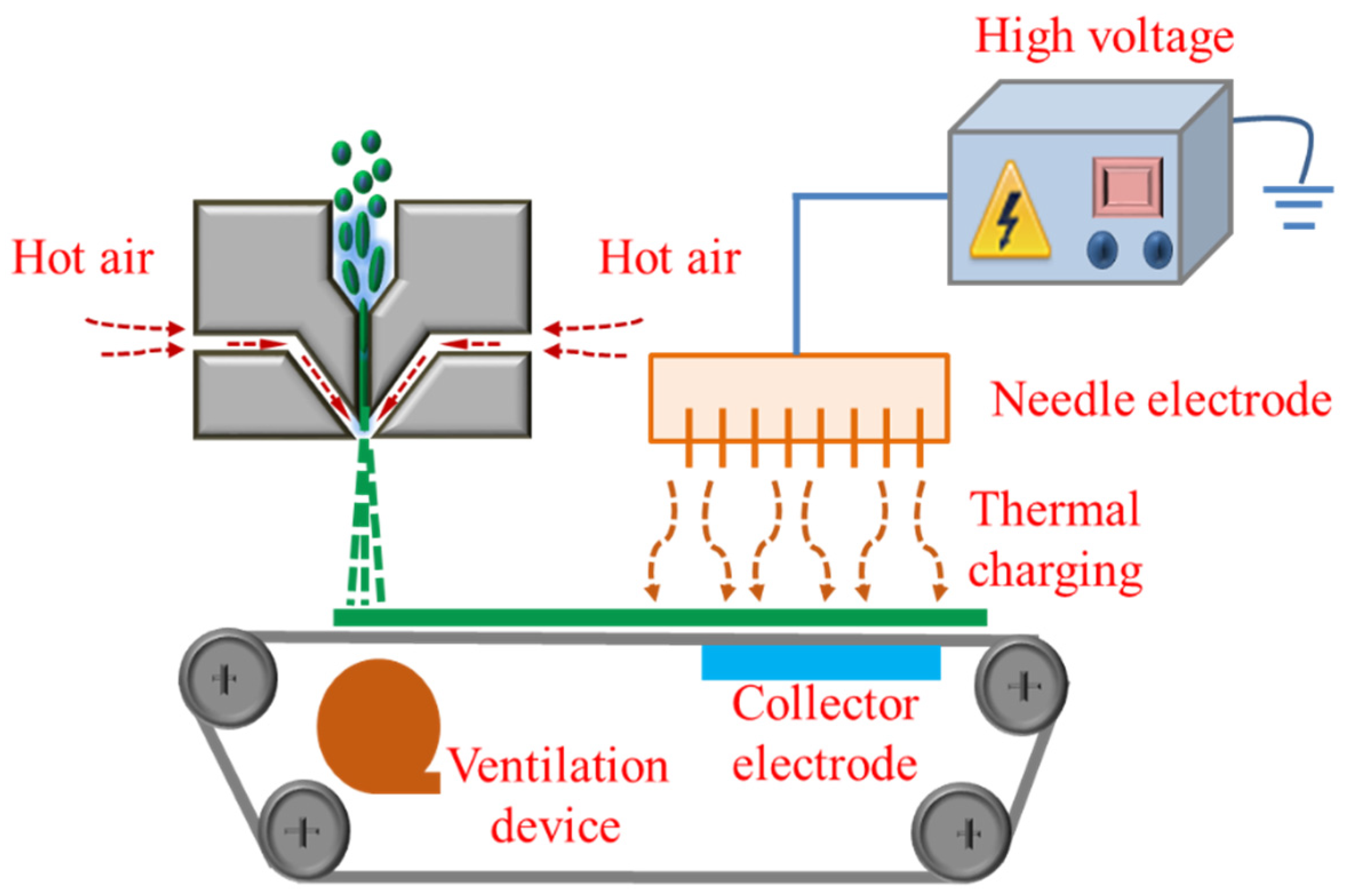

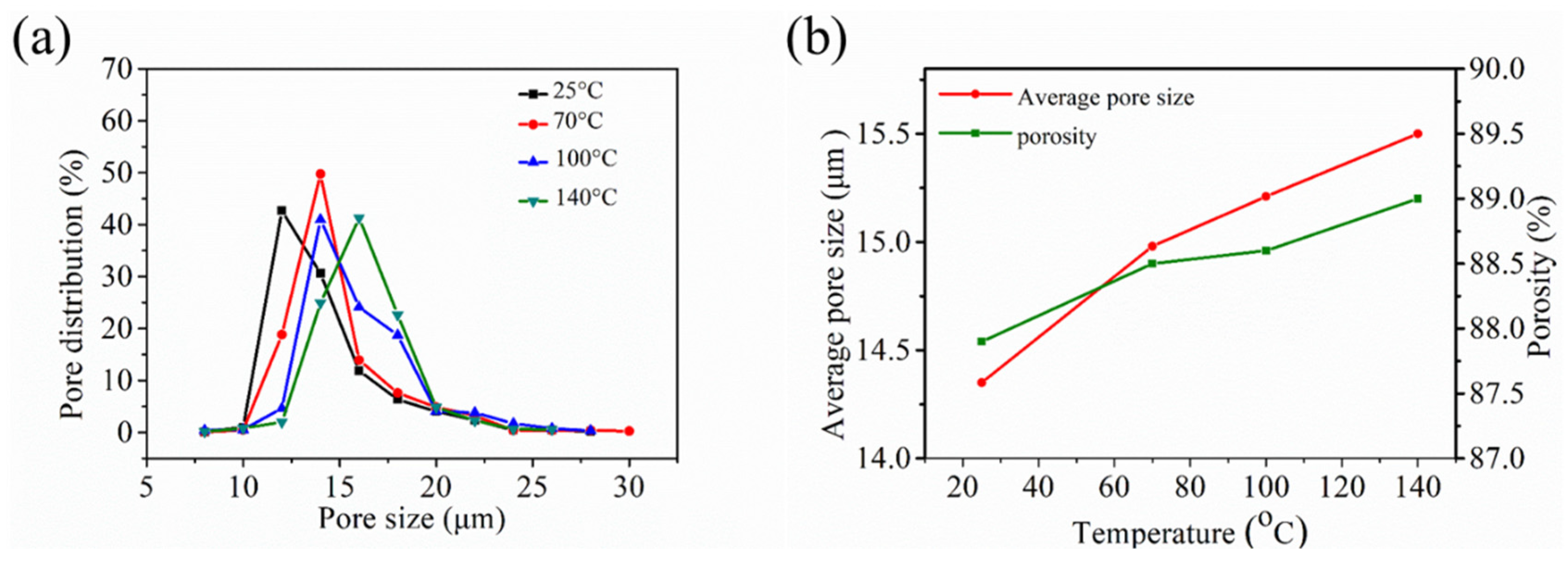

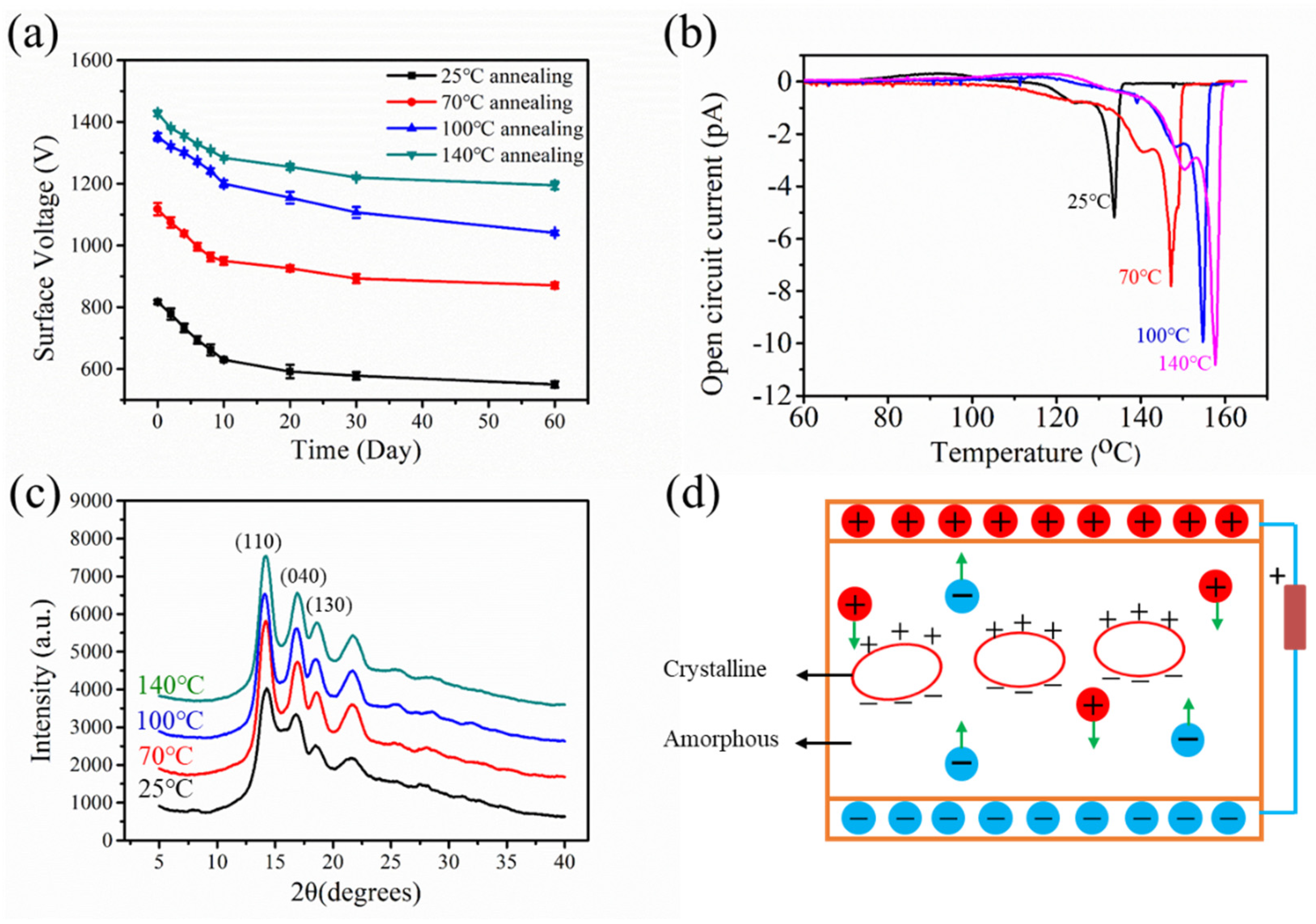
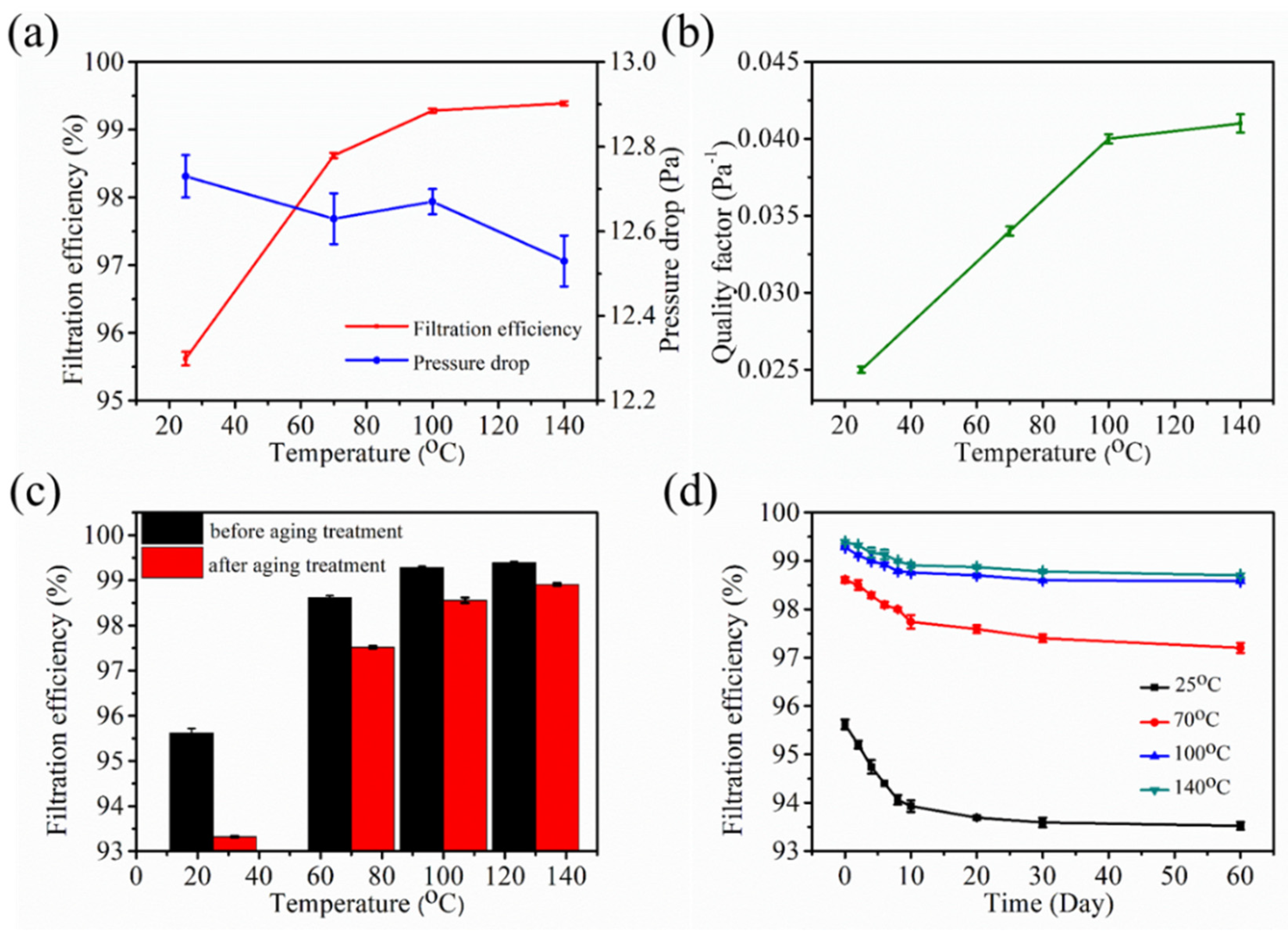
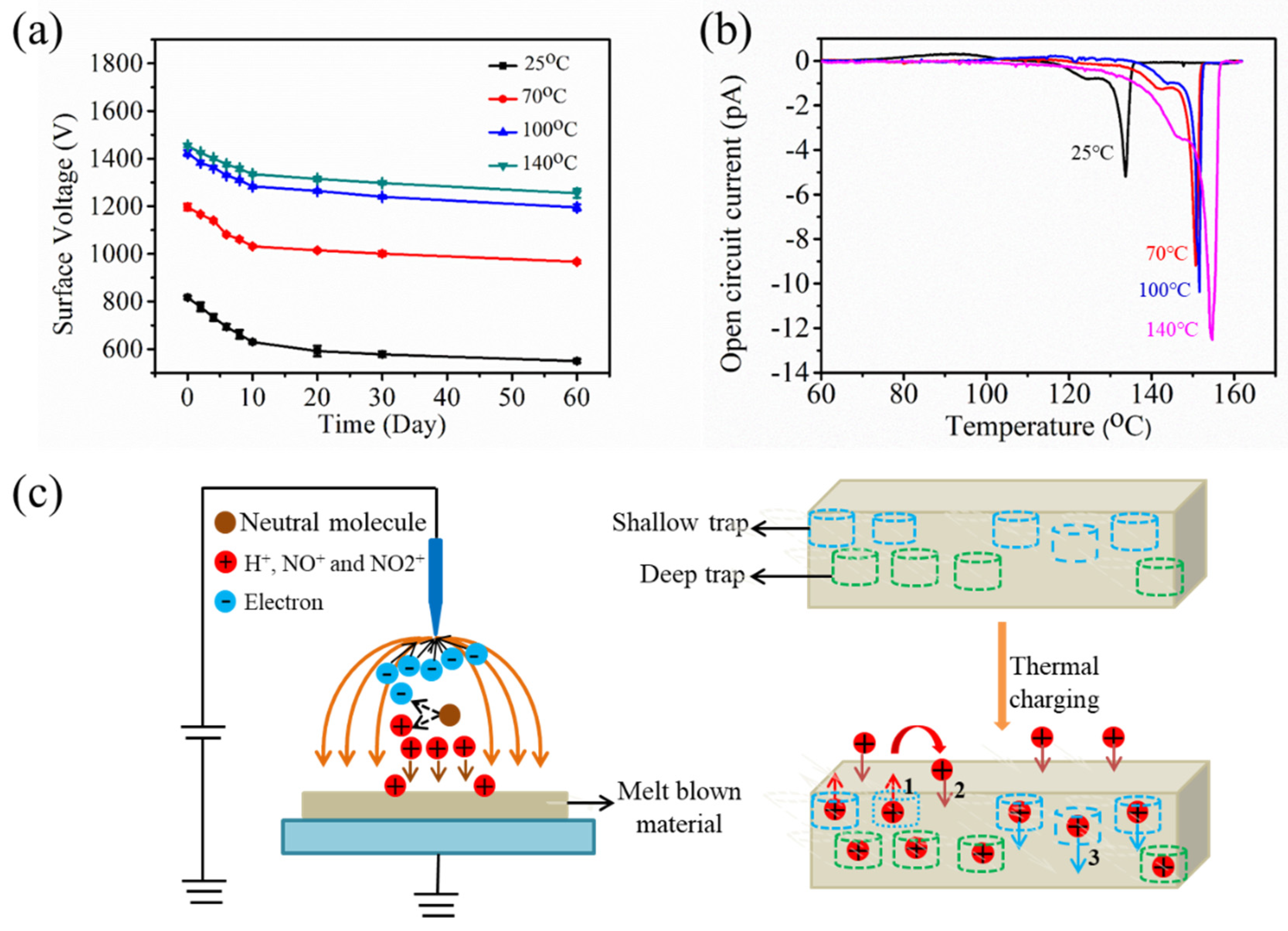
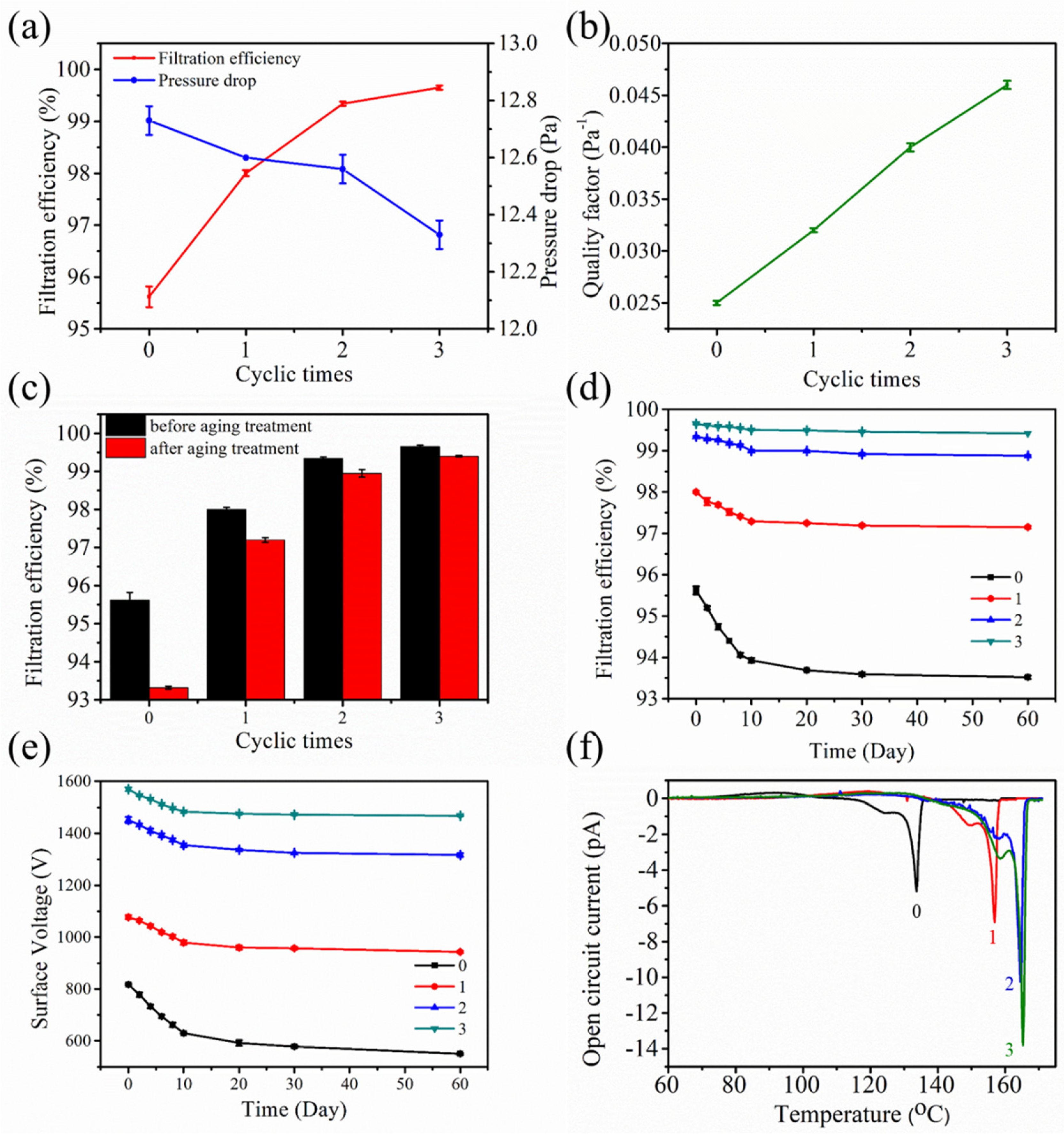
| Parameters | Screw 1 Temperature (°C) | Screw 2 Temperature (°C) | Screw 3 Temperature (°C) | Air Temperature (°C) | Distance (mm) | Air Pressure (MPa) |
|---|---|---|---|---|---|---|
| 280 | 325 | 330 | 300 | 100 | 0.20 |
| Sample | Crystallinity (%) | 2θ(°) | D (Å) | XS (Å) |
|---|---|---|---|---|
| 25 °C | 40.91 | 13.90 16.90 | 6.256 5.233 | 115 132 |
| 70 °C annealing | 44.98 | 14.00 16.90 | 6.281 5.227 | 103 122 |
| 100 °C annealing | 49.24 | 14.05 17.10 | 6.232 5.202 | 98 115 |
| 140 °C annealing | 58.35 | 14.10 17.15 | 6.215 5.185 | 83 103 |
© 2020 by the authors. Licensee MDPI, Basel, Switzerland. This article is an open access article distributed under the terms and conditions of the Creative Commons Attribution (CC BY) license (http://creativecommons.org/licenses/by/4.0/).
Share and Cite
Zhang, H.; Liu, N.; Zeng, Q.; Liu, J.; Zhang, X.; Ge, M.; Zhang, W.; Li, S.; Fu, Y.; Zhang, Y. Design of Polypropylene Electret Melt Blown Nonwovens with Superior Filtration Efficiency Stability through Thermally Stimulated Charging. Polymers 2020, 12, 2341. https://doi.org/10.3390/polym12102341
Zhang H, Liu N, Zeng Q, Liu J, Zhang X, Ge M, Zhang W, Li S, Fu Y, Zhang Y. Design of Polypropylene Electret Melt Blown Nonwovens with Superior Filtration Efficiency Stability through Thermally Stimulated Charging. Polymers. 2020; 12(10):2341. https://doi.org/10.3390/polym12102341
Chicago/Turabian StyleZhang, Haifeng, Nuo Liu, Qianru Zeng, Jinxin Liu, Xing Zhang, Mingzheng Ge, Wei Zhang, Suying Li, Yijun Fu, and Yu Zhang. 2020. "Design of Polypropylene Electret Melt Blown Nonwovens with Superior Filtration Efficiency Stability through Thermally Stimulated Charging" Polymers 12, no. 10: 2341. https://doi.org/10.3390/polym12102341
APA StyleZhang, H., Liu, N., Zeng, Q., Liu, J., Zhang, X., Ge, M., Zhang, W., Li, S., Fu, Y., & Zhang, Y. (2020). Design of Polypropylene Electret Melt Blown Nonwovens with Superior Filtration Efficiency Stability through Thermally Stimulated Charging. Polymers, 12(10), 2341. https://doi.org/10.3390/polym12102341






